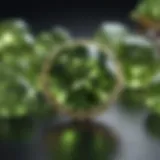How to Identify Authentic Diamonds: A Detailed Guide
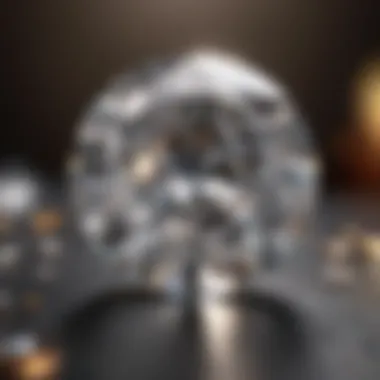

Intro
Diamonds have long captivated humanity, symbolizing not only wealth and love but also a unique beauty and intrigue that few other gemstones can match. This guide is dedicated to helping those interested in understanding diamonds more deeply—whether you're a gem enthusiast looking to bolster your knowledge, a collector on the hunt for that perfect stone, or a jewelry designer seeking authenticity in your creations.
By the end of this comprehensive piece, you’ll have a fundamental grasp of what makes a diamond a diamond, the nuances that differentiate a prized gem from mere glass, and how you can apply this knowledge in practical scenarios. With the right tools and understanding, distinguishing real diamonds from synthetic or poor-quality imitations becomes not just easier but also rather enjoyable.
Overview of Gemstones and Minerals
Understanding diamonds necessitates a broader knowledge of gemstones and minerals. Gemstones, by their very nature, are not just pretty trinkets; they have a rich history and significance intertwined with human culture.
History of Gemstone and Mineral Use
Throughout ages, different societies have placed varying importance on gemstones. Ancient Egyptians adorned themselves with lapis lazuli, believing it held mystical properties. In medieval Europe, gemstones acted as currency and status symbols. Diamonds, in particular, have a storied past that includes tales of power and magic.
Significance in Culture and Society
From engagement rings to crowns of royalty, diamonds epitomize us; they resonate with significance beyond mere aesthetics. They often represent major life events; getting married or celebrating anniversaries. Their cultural symbolism only adds to their allure.
Gemstone Formation and Properties
To truly understand diamonds, one must first grasp how these marvelous stones are formed and what attributes define them.
Formation Process of Gemstones
Diamonds form deep within the Earth under extreme pressure and temperature conditions. This geological drama takes billions of years and is what makes genuine diamonds so unique. Other gemstones have different origins, yet, they share a similar awe-inspiring journey from the Earth’s crust to jewelry stores.
Properties that Define Gemstones
Each gemstone exhibits specific properties that set it apart. Diamonds are notably the hardest known mineral, rated a perfect 10 on the Mohs scale. This quality not only enhances their appeal but actually plays a role in their market value. Room for a deeper appreciation of these properties also helps in distinguishing true gems.
Classification based on Color, Hardness, and Luster
Gemstones can be classified through numerous attributes like color, hardness, and luster. Understanding these classifications can be particularly beneficial when you encounter a plethora of options at a jewelry shop. Color can give insight into potential treatment or enhancement, while hardness speaks to durability.
Types of Gemstones
Precious vs. Semi-Precious Gemstones
Not all gemstones are created equal. Diamonds, emeralds, sapphires, and rubies are recognized as precious stones, while all the rest, such as amethyst or garnet, fall into the semi-precious category. However, this classification isn't straightforward; some semi-precious stones can fetch high prices too, depending on context.
Common Gemstone Varieties
In this realm, variety reigns supreme. Diamonds come in various cuts and styles, including the classic round brilliant cut or more contemporary princess cut. Each shape affects the gem's sparkle and brilliance, heightening or diminishing its desirability.
Exotic and Rare Gemstones
Then we have the lesser-known yet stunning exotic stones like tanzanite and alexandrite. While most people know about diamonds, sapphires, and rubies, discovering these lesser-celebrated gems can be a rewarding experience for any collector.
Identifying and Evaluating Gemstones
Now we inch towards the heart of our guide—identifying and evaluating gemstones. This is where your understanding truly comes to life.
Factors Affecting Gemstone Value
Value can swing based on a multitude of factors: origin, rarity, color, and even market demand. In the case of diamonds, the clarity and cut serve as determining factors as well. Recognizing the significance of each attribute can lead you to make smarter purchasing decisions.
Techniques for Gemstone Identification
When it comes to learning how to identify a genuine diamond, practical techniques play a crucial role. The fog test, the water test, or even a simple look to the edges can yield different results. These straightforward methods can bolster confidence when shopping.
Assessing Gemstone Quality
Assessing quality encompasses understanding the four Cs: carat, cut, color, and clarity. Each of these factors plays a vital role in determining the overall value of the diamond. Mastery of these elements can set you above the average shopper.
Caring for Gemstones
After acquiring these treasures, caring for them is paramount.
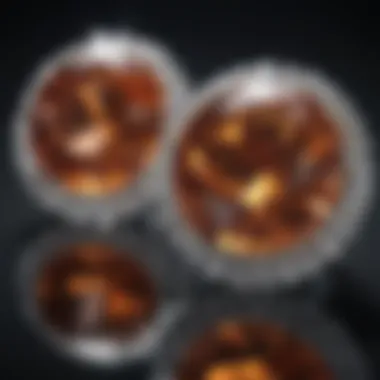

Cleaning and Storing Gemstones Properly
Regular cleaning not just sustains their appearance but also keeps them vibrant. It's advisable to utilize appropriate cleaning solutions suitable for each type of gemstone to avoid damage.
Avoiding Common Mistakes in Gemstone Care
Be mindful of easily overlooked mistakes, such as storing different types of gems together. This can lead to scratching or other forms of damage.
Preservation Tips for Specific Gem Types
Each gemstone might require different care strategies. For instance, while diamonds are durable, softer stones like opals or pearls demand extra attention and sensitivity to cleaning methods.
By acquiring a strong foundation on these topics, you can truly transform the way you perceive and engage with diamonds and other gemstones at a fundamental level. Understanding the richness, history, and value of these unique stones ultimately enhances transaction experiences and personal satisfaction.
Understanding Diamond Basics
When it comes to diamonds, grasping the fundamental aspects is key to making informed decisions, whether you're a casual buyer, an avid collector, or a jewelry designer. This section serves as your jumping-off point, outlining what diamonds are and how they form. Knowing the basics lays the groundwork for deeper dives into evaluation and authentication down the line.
What Is a Diamond?
At its core, a diamond is a solid form of carbon, where carbon atoms are arranged in a crystal structure known as a diamond lattice. What sets diamonds apart from other materials is not just this configuration, but also the robustness that results. They are, in fact, the hardest known natural substance on Earth. This unique hardness is a major reason why diamonds are coveted not only in jewelry but also in various industrial applications.
A diamond’s brilliance—its ability to reflect light beautifully—comes from the way it is cut. Each facet of the diamond plays a vital role in its sparkle. Furthermore, the context in which diamonds appear matters. They can be found in a variety of colors, such as blue, pink, and yellow, depending on the presence of other elements in the crystal lattice, primarily nitrogen and boron. Understanding these nuances can help one appreciate the diversity and value of these gemstones.
The Formation of Diamonds
Diamonds are not simply dug up from the ground. Their formation is a fascinating geological journey that takes millions of years. In natural settings, diamonds form deep within the Earth's mantle under high-pressure and high-temperature conditions. The process begins with carbon sources, either from the remnants of ancient organic materials or from the Earth itself. As the carbon undergoes intense conditions, it slowly transitions into a crystallized state.
Interestingly, the journey of diamonds doesn’t end once they burst through the Earth’s surface. They are typically brought up by volcanic eruptions through a type of rock called kimberlite. If you’ve ever come across the phrase, "pressure makes diamonds," it rings particularly true in this context. The journey and transformation highlight the extraordinary conditions required to create these precious stones.
Understanding these basics—what diamonds are and how they form—not only enriches your knowledge but also sets a solid foundation for discussing their authenticity. In the world of gemstones, being armed with information about the origin and characteristics of diamonds makes you a more discerning buyer and aficionado.
The Four Cs of Diamonds
When diving into the intricacies of diamonds, the categorization known as the "Four Cs"—Carat, Cut, Color, and Clarity—emerges as a crucial framework for understanding these precious stones. Each element holds its own significance, impacting not only the diamond's beauty and value but also how these stones are perceived in the market. For gemstone enthusiasts and collectors alike, a clear grasp of these Cs can mean the difference between making an informed choice or falling for a clever imitation.
Carat: Understanding Weight
Carat weight measures how much a diamond weighs, with one carat equivalent to 200 milligrams. While it is one of the most straightforward aspects to comprehend, carat weight is often misunderstood. For example, two diamonds with the same carat weight can vastly differ in size due to their cut and proportions. Bigger doesn't always mean better!
A few key takeaways about carat:
- Market Perception: Larger diamonds tend to fetch higher prices, which can distort perception. A one-carat diamond in some scenarios could carry a price tag noticeably heftier than that of a smaller diamond, even if their inherent qualities (cut, clarity, etc.) might be the same.
- Rarity: As with many gemstones, larger diamonds are rarer. This scarcity drives demand and thus affects pricing.
- Visual Impact: For those who prioritize sheer size, carat weight is a significant consideration. But one must balance this with the other Cs for the overall aesthetic appeal of the stone.
Cut: The Art of Shaping
The cut of a diamond is where artistry meets science. Contrary to common belief, cut does not refer to the shape—like round or emerald—but rather how well the diamond was fashioned from its rough state. The quality of the cut impacts the stone's brilliance, sparkle, and overall optical performance. A well-cut diamond can enhance its visual appeal immensely, while a poorly cut diamond can appear dull and lifeless.
Important aspects of cutting include:
- Facets: The angles and proportions of a diamond’s facets determine how light is reflected and refracted, significantly influencing sparkle. A diamond might have beautiful color but sparkle appears lifeless without a proper cut.
- Symmetry: How well the facets align can affect the way light travels through the stone. A symmetrical cut will often enhance the diamond's appearance.
- Grades: Cut quality is commonly graded as Excellent, Very Good, Good, Fair, and Poor. Choosing a diamond with a higher cut grade often promises a more dazzling display.
Color: Evaluating Hue
When it comes to diamonds, color assessment can be deceptive. Most diamonds fall within a spectrum where completely colorless stones display the utmost value. However, as one moves down the scale, even slight tints can start to diminish a diamond’s perceived worth.
Consider the following:
- Color Grading Scale: Diamonds are commonly graded on a scale from D (colorless) to Z (light yellow). The closer to D, the more valuable the diamond tends to be.
- Impact of Color on Overall Look: In some cases, a diamond with a slight brown or yellow hue can still be appealing, especially when set in certain metals like yellow gold, as it might complement more than conflict with its color.
- Fancy Colors: Beyond the traditional grading scale, diamonds can also exhibit intense shades like blue, pink, and green. The rarity of these stones can elevate their value immensely.
Clarity: Assessing Purity
Clarity measures the presence of inclusions or blemishes within or on the surface of the diamond. The clearer the stone, the more valuable it is considered. However, it’s worthwhile to understand that some inclusions can be microscopic and may not affect the diamond's appearance to the naked eye.
In clarity ratings, here are the basics:
- Clarity Scale: The scale runs from Flawless (no inclusions visible under 10x magnification) to Included (obvious inclusions visible to the naked eye). Many diamonds might fall into the VS (Very Slightly Included) category, where imperfections are minimal.
- Impact on Decision: Buyers should assess if the clarity detracts from visual appeal. Sometimes, a diamond with minor inclusions might present better value without sacrificing beauty compared to a higher-rated diamond.
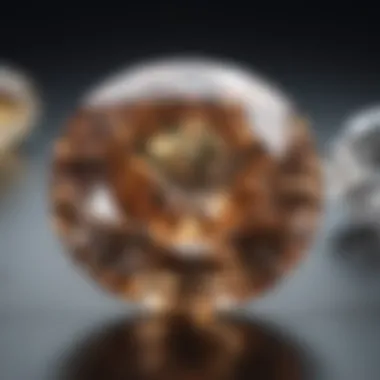

Identifying Genuine Diamonds
In the realm of gemstones, distinguishing a genuine diamond from imitations is akin to distinguishing a fine wine from a cheap bottle. As a potential buyer or a collector, understanding the nuances of authenticity can save you from buying a rock instead of a prized possession. This section delves into essential methods for identifying genuine diamonds, empowering you with knowledge that not only enhances your own collection but also elevates the conversation around it. Each diamonds is as unique as a fingerprint, and knowing how to recognize authenticity is a skill worth having.
Visual Inspection Techniques
The first line of defense when determining the legitimacy of a diamond is to visually inspect it. This involves a few tried-and-true methods that can be employed even by untrained eyes.
Using a Loupe
A loupe, or a jeweler's magnifying glass, is a small but mighty tool. When you hold a part-louped diamond up to your eye, you can spot imperfections or inclusions that speak volumes about its authenticity. Genuine diamonds often have minute flaws, a unique characteristic that can provide proof against lab-created stones that tend to be more perfect.
"Real diamonds usually have something just a bit off; it’s like they have a story to tell."
Despite their seeming simplicity, loupes are a popular choice among gem enthusiasts and professionals alike. They allow a closer inspection without needing advanced equipment, making it a practical choice. However, if you don't have steady hands, it might not be very easy to get a clear view, and it might take a bit of practice before you can use it effectively.
Checking for Sparkle
Sparkle isn't simply about how stunning a diamond looks; it’s about the unique way it reflects light. When light dances through a genuine diamond, it creates a dazzling display that imitators struggle to reproduce.
The key characteristic of checking for sparkle lies in the play of light within a diamond. A genuine diamond refracts light in numerous ways—showing flashes of color and brilliance that fake stones can't mimic. Test it under natural light: if it almost twinkles, you're likely looking at the real deal. The downside? Some synthetic stones like cubic zirconia can mimic this sparkle, leading to false positives.
Understanding Refraction
Refraction is like the secret handshake of gemstones. When you look at a diamond, you're actually witnessing a unique behavior of light as it passes through the stone. Genuine diamonds have a high refractive index, meaning they bend light more than most other materials. If you place a very fine-pointed pen behind a diamond, you'll notice the lines appear distorted.
This unique feature can help differentiate real diamonds from fakes. However, it's worth noting that some high-quality simulants also exhibit a degree of refraction, making this technique not foolproof. Nevertheless, understanding how light interacts with a diamond can deepen your appreciation for its complexity.
The Fog Test
One of the simplest home tests to determine a diamond's authenticity is the fog test. The principle behind it is straightforward: breathe on the stone to create a fog. This works because, unlike non-diamonds, which trap moisture in their pores, a real diamond will clear rapidly due to its superb thermal conductivity. If it clears up quickly, you probably have something genuine on your hands. If the fog lingers, it might be a fake.
Water Test for Authenticity
The water test is another straightforward method you can engage in without needing much expertise. Drop the diamond into a glass of water. A genuine diamond will sink quickly, thanks to its density. In contrast, more lightweight imitations may float or hover. While it’s not a definitive test—a well-cut zirconia can also sink—it's a quick and easy way to make an initial assessment.
By employing these techniques, you can bolster your confidence in identifying genuine diamonds. Remember, while no single test guarantees authenticity, a combination can work wonders to unveil the truth behind the sparkle.
Advanced Testing Methods
In the intricate world of diamonds, distinguishing a genuine gem from an imitation often requires more than the naked eye. That’s where advanced testing methods come into play. This section shines a light on reliable techniques that can provide gemstone enthusiasts, collectors, and jewelry designers with the assurance they need regarding their diamond purchases.
These methods not only enhance one's ability to evaluate diamonds accurately but also empower buyers to make educated decisions. The importance of using advanced testing methods lies in their scientific basis which can often reveal subtle features that casual evaluations might overlook.
"Advanced testing methods often provide the edge needed to confirm the authenticity of your diamond, ensuring you are investing in quality."
Professional Grading Reports
A professional grading report, often referred to as a certification, is a crucial document that provides an in-depth analysis of a diamond's characteristics. Organizations like the Gemological Institute of America (GIA) or the American Gem Society (AGS) typically conduct these evaluations.
These reports delve into a variety of factors including:
- The Four Cs (Carat, Cut, Color, Clarity)
- Specific dimensions and measurements of the stone
- Any treatments the diamond has undergone
Having a professional grading report is akin to having a well-detailed map before embarking on a journey. It shows you exactly what you’re dealing with, allowing you to navigate the complex world of diamonds with more confidence. While acquiring a certified diamond may come at a premium, this upfront investment pays off in long-term value and peace of mind.
Thermal Conductivity Testers
Another noteworthy instrument in the arsenal of advanced diamond testing is the thermal conductivity tester. Diamonds are unique in that they are excellent conductors of heat, surpassing most other gemstones. A thermal conductivity tester uses this property to determine authenticity. When you place a tester against a diamond, it measures how quickly heat dissipates. If the diamond conducts heat quickly, you can be fairly confident it is real.
However, one must be aware that some diamond simulants, such as moissanite, can also exhibit similar thermal conductivity. Therefore, while helpful, this method should ideally be used in conjunction with others for a definitive conclusion.
Use of Refractive Index
The refractive index, which refers to the degree to which light bends as it passes through a substance, serves as another method for assessing authenticity. Every gemstone has a unique refractive index, and diamonds boast a particularly high one, averaged at 2.42.
To measure this:
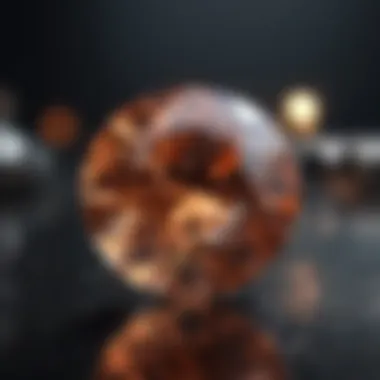

- A refractive index tool can be utilized, often contained within a small setup with a glass plate and a light source.
- Observing the way light passes through the diamond in contrast to simulants enables a clear distinction.
Using this method can be sophisticated and requires some practice, but once mastered, it can serve as an effective way to confirm diamond authenticity.
In summary, advanced testing methods not only solidify the authenticity of a diamond but also enrich the collector's knowledge about the gemstone they are acquiring. These methods provide a multi-layered approach to evaluation, offering clarity in what can sometimes be a bewildering market. Engaging with these techniques ensures that one can appreciate diamonds with a knowledgeable perspective, fostering a deeper connection to these magnificent stones.
Common Diamond Imitations
Understanding common diamond imitations is crucial for anyone looking to invest in or purchase genuine diamond jewelry. By recognizing these alternatives, buyers can avoid potential scams and make more informed decisions. Often, the visual appeal of these stones can be striking, but knowing their differences is key to discerning value and authenticity.
Moissanite vs Diamond
Moissanite is a primary competitor in the realm of diamond alternatives. Initially discovered in meteor fragments, it’s a naturally occurring mineral that also gets synthesized for jewelry purposes. The key difference lies in their optical properties. While diamonds exhibit brilliance and dispersion, moissanite’s refractive index allows it to have a higher sparkle, which often leads to confusion.
- Hardness: On the Mohs scale, both stones score a 9, making them durable for everyday wear.
- Price: Generally, moissanite is significantly more affordable, often costing one-tenth of a diamond of similar size and appearance.
- Color: Natural diamonds come in various colors, while moissanite can sometimes be near-colorless but often displays a slight yellow or gray tint when compared side by side with a diamond.
Considering all these elements helps in distinguishing these two gemstones, enriching one’s knowledge about what can pass for a diamond.
Cubic Zirconia: A Close Replica
Cubic zirconia (CZ) is another material frequently mistaken for diamonds. A synthetic stone, it was created as a diamond substitute in the 1970s and has since gained popularity due to its low cost and impressive aesthetic.
- Clarity: CZ is typically flawless in clarity, which can be appealing, but this very quality can alert knowledgeable gem enthusiasts.
- Weight: It’s heavier than diamond, a fact that can be useful during the inspection.
- Lifespan: Unlike diamonds, which can withstand the test of time and wear, CZ tends to fade and scratch over the years, making it less desirable for long-term investment.
When assessing value, it's important to consider how cubic zirconia differs in overall wearability and long-term appeal, as these factors can significantly influence one’s choice.
Other Synthetic Alternatives
Other than moissanite and cubic zirconia, various synthetic alternatives exist in the market that can mimic the appearance of diamonds. These materials can sometimes be deceptively similar, making the identification process even more challenging.
- Synthetic Diamonds: Created in labs, they possess the same properties as natural diamonds, making them true diamonds in every sense but origin. This means they can often pass all traditional testing methods.
- Topaz and Tourmaline: Though less frequent as diamond substitutes, colorless topaz and certain varieties of tourmaline can catch the eye and are sometimes marketed similarly.
Each alternative brings its own character and considerations to the table, adding complexity to the diamond imitation landscape. A discerning buyer should educate themselves on the specifics to ensure that the investment they make aligns with their intentions and expectations in the world of gemstones. > "Knowing your stones well can save you a pretty penny and keep you from being fooled."
Caring for Your Diamond
Caring for your diamond is crucial in maintaining its brilliance and value over time. Diamonds, admired for their beauty and durability, still require attention to keep them looking their best. Regular care not only preserves their sparkle but also enhances their longevity. When you invest in a diamond, whether it’s part of jewelry or a collector's stone, treating it with respect and proper care is essential. The maintenance process includes cleaning and storage, both of which play significant roles in ensuring your diamond remains stunning for generations to come.
Cleaning Techniques
Cleaning a diamond is pivotal in showcasing its true beauty. Oils, dirt, and dust can accumulate on the surface, dulling its shine. Here are some practical cleaning methods:
- Mild Soap and Water: One of the simplest methods is using a solution of warm water and a few drops of mild dish soap. Soak the diamond for about 20 to 30 minutes. Then, gently scrub it with a soft-bristled toothbrush to get rid of any grime. Rinse well with lukewarm water and dry with a lint-free cloth.
- Ammonia Solution: For a deeper clean, a mixture of one part ammonia to six parts water can be used. Dip your diamond in this solution for a limited time, ensuring not to use this too often, as ammonia can be harsh on certain settings.
- Ultrasonic Cleaners: While these devices can be effective, caution is needed here. Some diamonds, particularly those with fractures, may not be suitable for ultrasonic cleaning. Always check the diamond's resilience before opting for this method.
It's best to refrain from using abrasive cleaners or brushes, as these can scratch or damage the diamond.
"A well-cared-for diamond not only dazzles but tells a story of the moment it was chosen and the care it has received since."
Storage Recommendations
Storing your diamond correctly is just as important as cleaning it. The way you store a diamond can prevent scratches, chips, and other damage. Here are some pointers for proper storage:
- Separate Storage: Diamonds should always be stored separately from other jewelry to avoid scratches. Using individual pouches or a dedicated jewelry box with compartments can be quite effective.
- Use Soft Cloths or Padded Pouches: When storing, wrap your diamond in a soft cloth or place it in a padded pouch. This minimizes direct contact with hard surfaces, which could lead to unwanted damage.
- Avoid Humidity and Sun: Keeping your diamond in a cool and dry place is key. Excess moisture can lead to cloudiness, especially if the diamond has been exposed to water during cleaning.
- Regular Inspections: Periodically check your diamonds for any signs of loosening in their setting or wear and tear. Early detection of issues can save both the diamond and potential hefty repair costs.
By following these straightforward cleaning and storage practices, you can assure that your diamond remains as brilliant as the day it was acquired.
Ending
Understanding how to tell if a diamond is genuine carries significant weight in both personal and financial realms. For gemstone enthusiasts and collectors, recognizing authentic diamonds from imitations isn't just about aesthetics; it speaks to the integrity of investment. A genuine diamond not only symbolizes lasting love but also reflects the careful selection and knowledge of its owner. It’s essential to be well-versed in the attributes that define diamonds—like the Four Cs—as well as the methods available to assess authenticity.
Moreover, having clarity on different types of diamond imitations can prevent costly mistakes. While stones like moissanite and cubic zirconia may replicate the sparkle, they lack the intrinsic value associated with real diamonds. Thus, a comprehensive understanding can influence purchase decisions, ensuring that you invest in what truly holds value over time.
Also, using proper care techniques will safeguard the quality and longevity of your diamond. This guide reflects an accumulation of wisdom that not only benefits buyers but also enriches their appreciation for these beautiful gems. Equipping yourself with knowledge, skills, and understanding ultimately deepens the connection one has with these exquisite stones.
"Knowledge is a treasure, but practice is the key to it."
In summation, this journey through the world of diamonds emphasizes the importance of education and vigilance. As you navigate this intricate landscape, remember that informed decisions lead to better experiences, turning diamond appreciation into an avocation rather than mere acquisition.
Key Takeaways
- Invest in Knowledge: Understanding the Four Cs—carat, cut, color, clarity—can help ensure you make informed purchasing decisions.
- Beware of Imitations: Familiarize yourself with common substitutes like moissanite and cubic zirconia to avoid financial pitfalls.
- Assess Authenticity: Use various at-home testing methods, such as the water test and fog test, alongside professional evaluations to confirm a diamond's genuineness.
- Care Counts: Regularly clean and appropriately store your diamond to maintain its brilliance and value.
- Enjoy the Journey: Becoming knowledgeable about diamonds enhances appreciation and enriches your experience in the gemstone world.
By integrating these principles, one can confidently navigate the diamond market, armed with the awareness required to discern the true gems from the pretenders.
